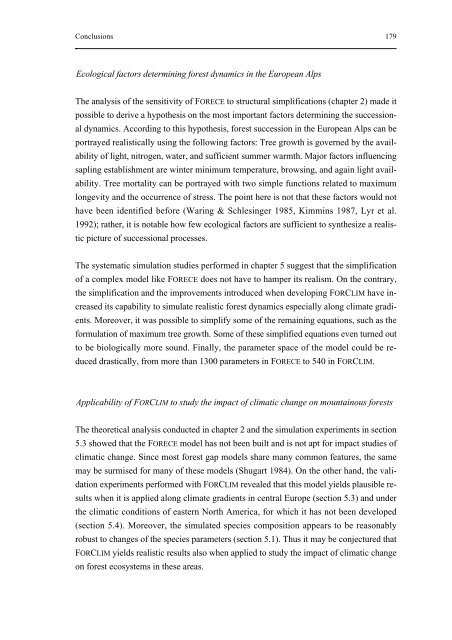On the Ecology of Mountainous Forests in a Changing Climate: A ...
On the Ecology of Mountainous Forests in a Changing Climate: A ...
On the Ecology of Mountainous Forests in a Changing Climate: A ...
You also want an ePaper? Increase the reach of your titles
YUMPU automatically turns print PDFs into web optimized ePapers that Google loves.
Conclusions 179<br />
Ecological factors determ<strong>in</strong><strong>in</strong>g forest dynamics <strong>in</strong> <strong>the</strong> European Alps<br />
The analysis <strong>of</strong> <strong>the</strong> sensitivity <strong>of</strong> FORECE to structural simplifications (chapter 2) made it<br />
possible to derive a hypo<strong>the</strong>sis on <strong>the</strong> most important factors determ<strong>in</strong><strong>in</strong>g <strong>the</strong> successional<br />
dynamics. Accord<strong>in</strong>g to this hypo<strong>the</strong>sis, forest succession <strong>in</strong> <strong>the</strong> European Alps can be<br />
portrayed realistically us<strong>in</strong>g <strong>the</strong> follow<strong>in</strong>g factors: Tree growth is governed by <strong>the</strong> availability<br />
<strong>of</strong> light, nitrogen, water, and sufficient summer warmth. Major factors <strong>in</strong>fluenc<strong>in</strong>g<br />
sapl<strong>in</strong>g establishment are w<strong>in</strong>ter m<strong>in</strong>imum temperature, brows<strong>in</strong>g, and aga<strong>in</strong> light availability.<br />
Tree mortality can be portrayed with two simple functions related to maximum<br />
longevity and <strong>the</strong> occurrence <strong>of</strong> stress. The po<strong>in</strong>t here is not that <strong>the</strong>se factors would not<br />
have been identified before (War<strong>in</strong>g & Schles<strong>in</strong>ger 1985, Kimm<strong>in</strong>s 1987, Lyr et al.<br />
1992); ra<strong>the</strong>r, it is notable how few ecological factors are sufficient to syn<strong>the</strong>size a realistic<br />
picture <strong>of</strong> successional processes.<br />
The systematic simulation studies performed <strong>in</strong> chapter 5 suggest that <strong>the</strong> simplification<br />
<strong>of</strong> a complex model like FORECE does not have to hamper its realism. <strong>On</strong> <strong>the</strong> contrary,<br />
<strong>the</strong> simplification and <strong>the</strong> improvements <strong>in</strong>troduced when develop<strong>in</strong>g FORCLIM have <strong>in</strong>creased<br />
its capability to simulate realistic forest dynamics especially along climate gradients.<br />
Moreover, it was possible to simplify some <strong>of</strong> <strong>the</strong> rema<strong>in</strong><strong>in</strong>g equations, such as <strong>the</strong><br />
formulation <strong>of</strong> maximum tree growth. Some <strong>of</strong> <strong>the</strong>se simplified equations even turned out<br />
to be biologically more sound. F<strong>in</strong>ally, <strong>the</strong> parameter space <strong>of</strong> <strong>the</strong> model could be reduced<br />
drastically, from more than 1300 parameters <strong>in</strong> FORECE to 540 <strong>in</strong> FORCLIM.<br />
Applicability <strong>of</strong> FORCLIM to study <strong>the</strong> impact <strong>of</strong> climatic change on mounta<strong>in</strong>ous forests<br />
The <strong>the</strong>oretical analysis conducted <strong>in</strong> chapter 2 and <strong>the</strong> simulation experiments <strong>in</strong> section<br />
5.3 showed that <strong>the</strong> FORECE model has not been built and is not apt for impact studies <strong>of</strong><br />
climatic change. S<strong>in</strong>ce most forest gap models share many common features, <strong>the</strong> same<br />
may be surmised for many <strong>of</strong> <strong>the</strong>se models (Shugart 1984). <strong>On</strong> <strong>the</strong> o<strong>the</strong>r hand, <strong>the</strong> validation<br />
experiments performed with FORCLIM revealed that this model yields plausible results<br />
when it is applied along climate gradients <strong>in</strong> central Europe (section 5.3) and under<br />
<strong>the</strong> climatic conditions <strong>of</strong> eastern North America, for which it has not been developed<br />
(section 5.4). Moreover, <strong>the</strong> simulated species composition appears to be reasonably<br />
robust to changes <strong>of</strong> <strong>the</strong> species parameters (section 5.1). Thus it may be conjectured that<br />
FORCLIM yields realistic results also when applied to study <strong>the</strong> impact <strong>of</strong> climatic change<br />
on forest ecosystems <strong>in</strong> <strong>the</strong>se areas.















